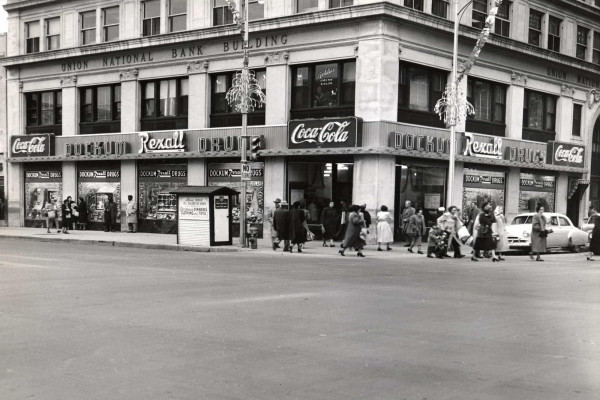The Dockum Sit-in: Wichita’s Successful Story of Desegregating Convenience Stores
February 14, 2022
By: Kaysey A. Richardson
When learning about the Civil Rights movement, we learn about the big moments that happened on a national level. While these occurrences are certainly important, oftentimes there are events that took place right here in our own city that tend to get overlooked. The story of the Dockum Drug Store Sit-In that took place here in Wichita, Kansas is a key example of this.
On a hot and sunny Thursday in July of 1958, the famous Douglas Street of Wichita was bustling with people. At the time, most stores and restaurants were located on Douglas, including the Dockum Drug Store. Dockum was the place to go to grab a Coke and food with friends. Located inside the drug store was a lunch counter with seats that were lined up where students could sit down, talk with friends, and enjoy their Coke. For the Black patrons of Wichita, there was no such luxury. Rather than being allowed to sit inside during a warm summer’s day, African Americans were forced to consume their Coke and food outside of the store. On this day, a group of young people sought to change that.
The plan for this sit-in had been underway for about two years, with the idea sparking from a late-night conversation that the leaders of the NAACP youth group, Carol Parks and Ron Walters, had with the NAACP’s western region director, Franklin Williams. Williams informed the two that in the 1940s the Congress of Racial Equality (CORE) conducted a series of sit-ins across the United States as a form of peaceful and effective protesting. From 1956-1958, Williams continued to visit Wichita and speak with NAACP youths on how they can take these techniques to fight racial discrimination on a local level.
The idea to begin a series of sit-ins at Dockum sparked in the summer of 1958 when Joyce Glass, a sixteen-year-old, stopped into the drug storeand attempted to order something to drink. Upon arrival, she was refused service. Angered by the refusal to be served, Joyce went back to her sister, Lequeatta Glass, secretary of the NAACP youth group, and told her what happened. Lequeatta then brought forward this story to the group, and so began the plan to conduct the sit-in.
They intended to start with the Dockum Drug Store then move their protests to other chain stores in downtown Wichita. Robert Dockum, the president of the drugstore, owned nine stores throughout Wichita and his family had been in business for over fifty years. Interestingly, Dockum actually employed African Americans, one including Don Brown. Brown recalled that a Dockum son informed him that blacks were not allowed to eat lunch at the counter because “that’s the way things are in Wichita.”
On July 19, 1958, Parks and Walters, along with other Black students, began to enter the drugstore everyday to fill the stools at the counter and ordered a soft drink. The students were quiet, polite, and did not cause any ruckus, yet still denied service. Students continued to fill Dockum and order a drink everyday for a month. There was pushback from many white patrons, but never violence and never enough to stop the protest. August 11, 1958, the students would see success after the owner of Dockum said, “Serve them—I’m losing too much money.” In an interview four decades later, Ron Walters recalled what happened:
“This is what we were hoping for—a shut-off of the flow of dollars into this operation…by the second week we felt that we were winning because we were being allowed to sit on the stools for long periods. Surely the store was losing money. As we sat, we seldom spoke to each other, but many things crossed my mind. How would I react if my white classmates came in? How would they react? Would my career in college be affected, and would I be able to get another job? Were we doing the right thing after all? I am sure others were thinking the same things, but they never wavered. I was proud of our group. Gradually, the word got out that there was something going on in the Dockum drugstore. The store soon filled not only with shoppers, but also the curious and the hostile. The press came in, and I was interviewed by radio and newspaper reporters, but they were never to return.”
After the owner confirmed to his management and servers that they would be served, they instructed the staff that moving forward the store would not discriminate against customers based on race, creed, or color. This group of young, black students successfully desegregated the largest chain store not only in the city of Wichita, but every store in the state of Kansas. This event inspired another protest eight days later in Oklahoma, a sit-in at Southwestern University in Winfield, Kansas, and several other towns in the states of Oklahoma and Kansas.
The Dockum sit-in was an inspiration to so many other cities and states in the Midwest, yet it never gained national attention. This event took place two years before the famous sit-in in Greensboro, North Carolina, which is often credited as the beginning of the modern sit-in movement. I have lived in both Texas and Kansas for my entire adult life and one thing that I have found, is that no matter where I live, there are stories like this one that are oftentimes overlooked and remain untold. Whether you are reading this blog right here in Wichita, or came across this from another state, I encourage you to visit your local archives or libraries—or even do a quick google search—and find a local story that can be connected to our nation as an entirety. You’ll be surprised what history you can find that took place right in your very community.

References and Further Reading:
Dissent in Wichita by Gretchen Cassel Eick
https://www.kshs.org/kansapedia/dockum-drug-store-sit-in/17048